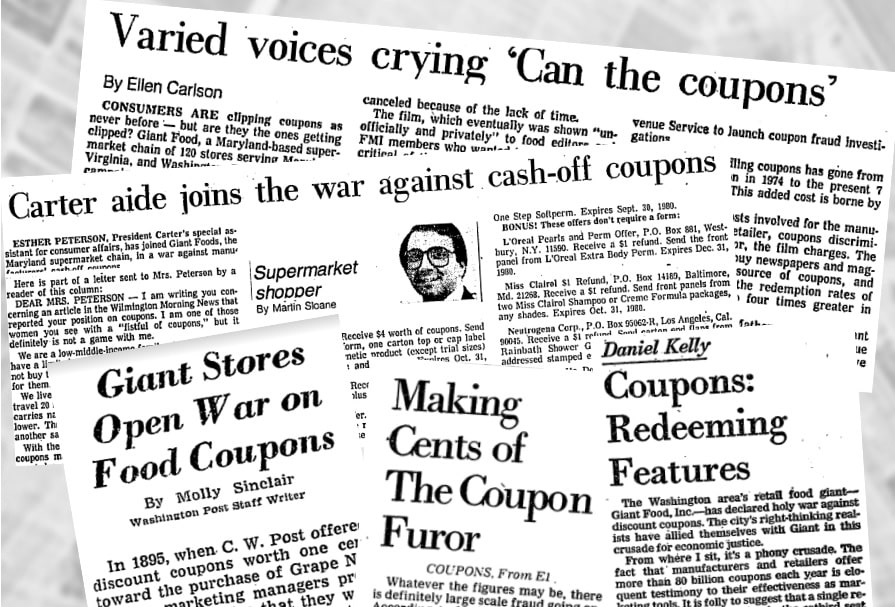
It’s time to democratize discounts, some say – coupons that some can use and others aren’t able to access are discriminatory to shoppers who need them the most, so stores and manufacturers should simplify the whole process and ensure the same deals are available to everyone.
Does that sound like a debate happening in 2024? Try 1980.
In a growing number of states across the country, legislators and consumer advocates are currently arguing that digital-only coupons and deals are unfair to the elderly, to low-income and other shoppers who lack digital access or understanding.
While the debate over digital coupons is decidedly modern, it’s similar to the argument that reached a fever pitch more than four decades ago, as a major grocery chain and an adviser to the President of the United States made headlines by saying couponing was becoming unfair, and it was time to do something about it so shoppers who most needed grocery discounts weren’t left behind.
So you might say coupon history is repeating itself.
Back in 1980, there were no such things as digital coupons, of course. There were, however, plenty of printed coupons in newspapers and magazines, as couponing exploded in popularity in the midst of more than a decade of inflation.
But Esther Peterson, President Jimmy Carter’s special assistant for consumer affairs, together with Maryland-based Giant Food, decided they’d had enough. The two-tiered grocery pricing system that coupons had enabled, they argued, was doing more harm than good for shoppers desperate for savings.
“Giant said coupons aren’t available to low-income consumers who don’t buy many newspapers and magazines that publish the offers,” the Washington Post reported in June 1980. The retailer “conducted surveys in one of its markets in a poor neighborhood,” and found that its more affluent shoppers used four times as many coupons as the residents of the lower-income neighborhoods.
Peterson agreed with Giant’s assessment. “Those who don’t use the coupons, especially low-income consumers,” the Chicago Tribune quoted her as saying, “are the ones picking up the tab for couponing,” subsidizing discounts for shoppers who did use coupons.
Those reports emerged weeks after a retail industry convention, where Giant argued it was time to make the same discounts available to all shoppers, since couponing “is not fair to the poor.” In what can only be seen today as a curious conflict of interest, Peterson herself – a former Giant executive now serving as a government-appointed consumer advocate – appeared in a Giant-produced video, supporting Giant’s argument.
So you could say there are certainly echoes of that 44-year-old debate in the present-day debate over digital coupons. Just over a year ago, consumer groups led by Consumer World founder Edgar Dworsky issued a public call to a dozen large grocery chains, urging them to “stop discriminating against the digitally-disconnected, particularly seniors, and offer them the same discounts already enjoyed by tech-savvy shoppers.” That campaign caught the attention of a New Jersey state lawmaker, who proposed a law requiring any retailer offering a digital coupon to also make available “an in-store alternative” for the digitally-disconnected. Five other states have since proposed similar legislation, with some going even further in saying that all digital coupons should be applied to the the purchases of all shoppers, automatically.
These bills have become the most forceful and far-reaching arguments for the democratization of grocery discounts since that debate back in 1980. Yet there are some key differences. Today, advocates are looking to pass laws, while back then the proposed solution would have been voluntary. Today, the focus is on fairness and equity, while back then, there were additional motives behind the movement. And today, advocates are pushing to make more coupons available to more shoppers, while back then, advocates’ preferred solution was to do away with coupons altogether.
In fact, it became known as Giant’s “war on coupons.” While Peterson emphasized the argument that coupons were unfair to lower-income shoppers and we’d all be better off if everyone could get the same discounts, that was only one – and the least self-serving – of Giant’s arguments. Coupons also slow down checkout lanes, Giant complained. They require too much time and money to handle and process. There’s too much fraud (even back then). And some Giant shoppers purportedly “find coupons infuriating,” the Washington Post reported, “particularly people who hold down jobs outside the home and don’t have the time to spend clipping coupons or searching for the exact brand and size in the supermarket.” Besides, the paper noted, “the fact that more and more women are working may hasten the downward spiral of the couponing craze.”
That never happened, as many coupon advocates saw through Giant’s “war on coupons” as being more beneficial for Giant than for consumers. “More shoppers than ever before are saving money with coupons,” Supermarket Shopper columnist Martin Sloane argued. “As for the argument that coupons penalize low-income groups, the same could be said of all advertising. The family without newspapers – or magazines or radio or television – has more difficulty getting the best buys on products.” So why should coupons be treated any differently?
Sloane went on to echo the recent argument of a retail industry representative, who told New Jersey lawmakers that the solution to providing savings for the digitally-disengaged isn’t to give them the discounts anyway – it’s to help them become digitally-engaged. “If you really want to do something useful,” Sloane wrote four decades earlier, “you should be setting up a program of distributing newspapers to the poor and teaching them how to use these papers – including the coupons – to their economic advantage.”
A Washington Post columnist made a similar argument. “The poor, says Giant, do not buy the newspapers and magazines in which coupons appear. I’ll concede the point,” Daniel Kelly wrote. “This ‘discrimination,’ though, is not engraved on stone tablets. Shouldn’t we devote our consumer-protection energies to teaching the poor how to obtain coupons and how to use them wisely?”
For all the attention this coupon controversy earned back in the summer of 1980, though, it faded almost as quickly as it flared up. Peterson soon backed off her anti-coupon stance, admitting that there were indeed benefits to coupons for those who took the time to clip them. And Giant’s campaign was never embraced by other retailers, or by the manufacturers who issued the coupons that seemed to irk Giant so much. “It wasn’t an active ongoing campaign,” a Giant spokesperson rationalized a few months after the retailer went public with its coupon complaints. “We just felt it was something we wanted to bring to the attention of the public, and we did.”
In the end, whether it’s teaching 1980 shoppers the cost-effectiveness of buying a Sunday newspaper that more than paid for itself in grocery savings, instead of doing away with coupons altogether – or helping 2024 shoppers clip the digital coupons they can’t currently access on their own devices, instead of just giving away digital discounts to everyone across the board – coupons have always worked best when they reward those who put in a little effort.
“Coupons are a sort of new-and-improved Robin Hood,” Kelly observed back in 1980. “Those for whom saving a few bucks at the checkout counter is worth hours of effort will benefit at the direct expense of those who are unwilling to.”
Once again, though, the proposed solution to coupon inequality varies, between helping those who are willing to put in the effort but can’t, and automatically granting coupon discounts to those who put in no effort at all, in an attempt to be “fair.” Equal access to savings doesn’t necessarily mean equal savings for everyone – otherwise couponing as we know it may cease to exist.
That debate four decades ago died down pretty quickly. Today, however, it’s a debate that shows no sign of ending any time soon.










